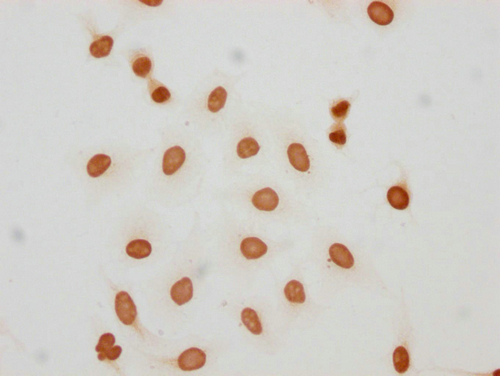
Immunocytochemistry analysis of CSB-PA010389PA05hibHU diluted at 1:150 and staining in Hela cells(treated with 30mM sodium butyrate for 4h) performed on a Leica BondTM system. The cells were fixed in 4% formaldehyde, permeabilized using 0.2% Triton X-100 and blocked with 10% normal goat serum 30min at RT. Then primary antibody (1% BSA) was incubated at 4°C overnight. The primary is detected by a biotinylated secondary antibody and visualized using an HRP conjugated SP system.
2-hydroxyisobutyryl-HIST1H2AG (K5) Antibody
CSB-PA010389PA05HIBHU
ApplicationsELISA, ImmunoCytoChemistry
Product group Antibodies
ReactivityHuman
TargetH2AC13
Overview
- SupplierCusabio
- Product Name2-hydroxyisobutyryl-HIST1H2AG (K5) Antibody
- Delivery Days Customer20
- ApplicationsELISA, ImmunoCytoChemistry
- CertificationResearch Use Only
- ClonalityPolyclonal
- ConjugateUnconjugated
- Gene ID8329
- Target nameH2AC13
- Target descriptionH2A clustered histone 13
- Target synonymsH2A histone family, member C; H2A.1; H2A/c; H2AC11; H2AC15; H2AC16; H2AC17; H2AFC; HIST1H2AI; histone 1, H2ai; histone cluster 1 H2A family member i; histone cluster 1, H2ai; histone H2A type 1; histone H2A/ptl
- HostRabbit
- IsotypeIgG
- Protein IDP0C0S8
- Protein NameHistone H2A type 1
- Scientific DescriptionCore component of nucleosome. Nucleosomes wrap and compact DNA into chromatin, limiting DNA accessibility to the cellular machineries which require DNA as a template. Histones thereby play a central role in transcription regulation, DNA repair, DNA replication and chromosomal stability. DNA accessibility is regulated via a complex set of post-translational modifications of histones, also called histone code, and nucleosome remodeling.
- ReactivityHuman
- Storage Instruction-20°C or -80°C
- UNSPSC12352203
